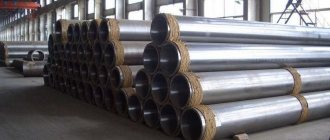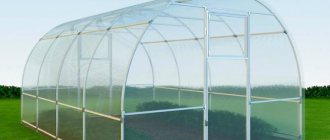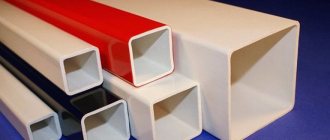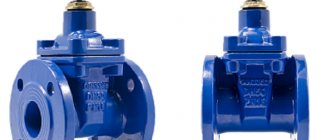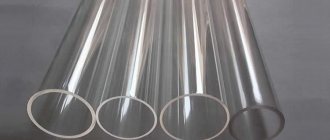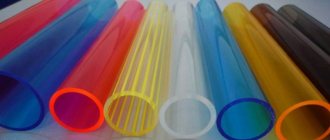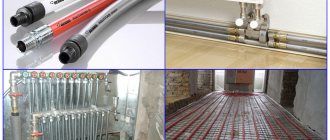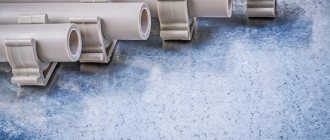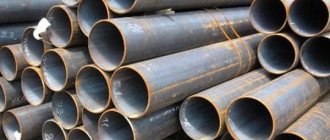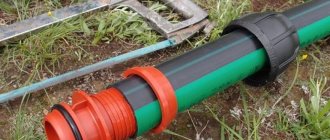PVC material was first discovered by the German chemist Regnald at the end of 1835. Since 1912, the search for possibilities for its production on an industrial scale began, and in 1931 the BASF concern received the first tons of this material. PVC (polyvinyl chloride, or thermoplastic polymer) is made from bleached plastic. This is a fairly hard material. The polymer is created chemically from tiny particles of petroleum products. Thanks to them, the durability of the product is maintained. All polymers are adapted to different climatic conditions (exposure to sunlight, moisture).
Petroleum products contain various modifier additives that are used for the manufacture of PVC profiles. Thermoplastic polymer withstands high temperature differences: from -50° to +60° C. Chemical formula: [-CH2-CHCl-]n. The service life of polymer profiles is approximately 20 years. PVC production experts note that the inherent hardness of the polymer helps preserve the properties of the material for 5-15 years. Rubber gaskets in this material are used for seals.
Classification of double-glazed windows by the number of chambers and their designations (abbreviations)
A formulaic entry may begin with an abbreviation indicating the number of cameras.
If SPO appears at the beginning, this means that the double-glazed window has one chamber. Formulas for double-glazed windows begin with the abbreviation SPD. Here SP is an abbreviation for “double-glazed window,” and O and D are, respectively, “single-chamber” or “double-chamber.” A single-chamber glass unit is a glass unit consisting of two glasses arranged in parallel and hermetically connected by one spacer frame. A double-glazed window is a design consisting of three glasses connected by two frames.
For example, this is what the formula for a single-chamber double-glazed window with a width of 24 mm will look like:
4M1-16-4M1 (4 mm – glass thickness, 16 mm – spacer frame width, M1 – glass type).
If, instead of regular float glass, energy-saving glass is used, then the formula will look different:
4M1-16-4i (here the internal glass ensures heat retention inside the room and protects the space from drafts, resistance to heat loss reaches 0.59 m2 C/W, compared to the previous formula - 0.32 m2 C/W).
But the calculation of the formula for a double-glazed window with a width of 32 mm looks different:
4M1-10-4M1-10-4M1 (the formula already takes into account three glasses and two spacer frames, 10 mm wide, thermal insulation is 0.47 m2 C/W).
If we replace regular glass with energy-saving glass, we get the following formula:
4M1-10-4M1-10-4i (the principle is the same, the inner glass is indicated by a different marking inherent in energy-saving glass, the thermal insulation increases to 0.64 m2 C/W).
The total thickness of the structure may be indicated in parentheses after the chamber designation. For example, the formula for a 32-mm double-glazed window is SPD(32) 4M1-10-4M1-10-4M1. Here you can see that the product is made up of three 4 mm glasses and two 10 mm frames, totaling 32 millimeters.
GOST R 54175-2010 “Glued double-glazed windows. Technical Specifications” also describes double-glazed windows with special properties, which are then displayed in the formula.
Their properties can also be included in the abbreviation in the form of letters:
UD - shock resistant; E - energy saving; C - sun protection; Ш - protected from noise; M - frost-resistant.
There are also multifunctional products that combine several properties, for example, energy-saving and noise-proof. These characteristics can be determined by the properties of the glass.
Advantages of uPVC pipes
The growing popularity of uPVC and PVC pipes is due to such advantages of their use as:
- reliability;
- durability;
- ease of installation;
- a sharp reduction in operating costs for pipeline maintenance;
- pipes are completely harmless to humans and the environment.
Nowadays, polymer pipes are widely used in the modernization of utility networks and in new construction. They replace pipes made of steel, cast iron and other materials.
Types of glass for double-glazed windows and its markings
Glass formulas in a double-glazed window reflect the thickness of the glass, its brand and characteristics. The belonging of a material to a specific type is indicated by letters, abbreviations or words.
Sheet glass
Standard double-glazed windows are made from M1 glass. The characteristics of this type are considered sufficient to ensure the required quality; the use of lower grades is not recommended by GOSTs. This material is transparent, it has a minimum of bubbles and optical distortions. This type of glass product is produced by drawing. In addition to M1, there are M0, M2, etc.
The decoding of the glass unit formula includes the thickness of the glass indicated in front of the brand. Glass sheets are used for 4, 6, 8, etc. millimeters.
The sheet type also includes float glass, designated by the symbol F or the word float. Float glass is flat and colorless; it differs from regular glass in the way it is made: a mixture of silicates is continuously cast onto liquid tin, followed by cooling.
When deciphering a double-glazed window, you can see the inscription 6Fjumbo. She's talking about 6mm thick float glass with larger dimensions. Jumbo is a type of architectural glass, the polished sheets of which reach record sizes of 6000x3210 millimeters.
Wired glass
It is designated by the letter A. Wire mesh is placed into the reinforced glass sheet at the production stage. It is made from low-carbon steel and serves to give the finished product safety and fire resistance. In the formula of a reinforced double-glazed window, the glass will come with the prefix “A”. For example: 4A-8-4M1 .
Self-cleaning glass is also marked with the letter A. Although they are often labeled as Active Clear, there are other properties to keep an eye on to avoid confusion: Wired glass comes in clear, colored, flat, wavy and ribbed - and they all have a mesh inside.
Triplex
Another name is laminated glass. The material consists of three glass layers, bonded with a special film or specific polymers. Thanks to this, it is able to withstand enormous loads, which classifies it as an impact-resistant product.
In the formula for a double-glazed window, triplex is designated as:
— 3.3.1 (two 3 mm glasses and 1 mm film); — 4.4.1 (two glasses of 4 mm each and a film of 1 mm); — MS 33.2 (two 3 mm glasses and 2 mm film); — Stratobel Clear 3.3.1 (4.4.1); — Optilam Clear 3.3.1 (4.4.1).
Depending on the characteristics, triplex can withstand impacts from a hard or soft body and exposure to fire. There are varieties that can protect not only from noise, but also from radiation interference.
Tinted glass
Or colored. It is divided into two subtypes: mass-tinted or reflective.
Tinted glass is classified as float glass. During production, metal oxides are added to the liquid glass raw material, which gives the finished product the required shade.
The most common colors are blue, grey, green and bronze. Designations:
— Planibel Gray (instead of Gray (gray) there may be a different shade, for example, Bronze (bronze)); — 4Ton (4T, 4 ton.mass., 4Ton) — thickness and toning without specifying color.
The reflex type has a characteristic mirror effect. Metal oxide is applied to its surface on one side using a pyrolytic method. Example of designation: Stopsol Classic Bronze, where another shade may be indicated instead of Bronze. This type also applies to solar control glass.
Strained glass
To give the glass additional strength, it is tempered in three ways:
— thermal hardening; — heat strengthening; - chemical hardening.
Thermal hardening increases safety: when glass breaks, it breaks into small fragments with blunt edges. Hardening takes place in special furnaces. The sheet heats up to 680 degrees Celsius and cools evenly. A product processed in this way is marked with the abbreviation ESG.
The heat strengthening process is similar. The main difference is that the cooling stage lasts longer. The resulting material is no longer considered safe: when broken, large sharp fragments are formed that can cut you. Marked as TVG.
For chemical tempering, a sheet of glass is placed in a salt solution and heated to a temperature of over 380 degrees Celsius. Under such conditions, sodium ions on the glass surface are replaced by potassium ions, which increases fracture strength and fire resistance.
Tempered glass can be marked with the symbols Zak or Z.
Solar control glass
This variety is characterized by an increased ability to reflect or absorb solar radiation. Divided into:
— tinted in mass; - reflex; — with a soft coating (has a nanocoating applied by the magnetron method).
Markings found:
— SunStop; — StopSol; — ANTELIO; - 4SGSolar.
Energy saving glass
Equipped with a soft or hard coating that reflects infrared radiation. Thanks to this feature, white sunlight passes freely into the room, but heat waves remain outside, which keeps it cool in summer. Home heat is also reflected from windows and remains inside, which protects against heat loss in winter.
Hard-coated glass is marked with the letter K. The coating is tin or indium oxide applied to a hot glass sheet. Another designation option is Pilkington K Glass.
The soft coating is applied using the vacuum-magnetron method. It is a silver oxide that reflects heat waves. This variety is designated by the letters I, I, E, or the words Top, Low-e, Top-N.
Other marking options:
— Pilkington Optitherm S1 and S3; — ClimaGard N; - CLGuN; - ENplus; — ZERO (ZERO-E); — Futur-N.
The formula for an energy-saving double-glazed window may look like this:
4i-14-4-14-4i
where, 4 – thickness in mm
And – type of glass, in this case it is energy saving
14 – width of the internal space
The heat transfer resistance coefficient when using such an energy-saving double-glazed window is 0.92 m2 C/W.
Multifunctional glass
Or highly selective. Such glasses combine the characteristics of energy-saving and sun protection. This property is achieved through the multi-layer application of special coatings, which completely transmit useful light but reflect heat. Designations:
— MF; — SunCool; — ClimaGard Solar; - GuSolar; — StopReyNeo; - SELEKT; — LifeGlassGear.
Disadvantages of PVC:
- minor restrictions on heat (thanks to thermal insulation, repairs and lining of equipment are carried out, PVC pipes have certain boundaries with the air temperature, about +60° C);
- quite expensive material (the price increases with the size of the pipe diameter);
- heavy material (relatively thick steel part covered with metal sheets);
- the difficulty of replacing metal products (these products are not produced in the same sizes and shapes by other companies, so you will have to order from suppliers);
- difficulty of disposal (when the material is burned, toxic organochlorine substances appear, which are popularly called toxins).
Marking of spacers and inter-chamber space for double-glazed windows
Spacer frames separate the glass sheets in a double glazing unit. If they are made of aluminum (the most common case), then this is not noted in any way; the formula then reflects only the thickness in millimeters.
If a frame is made with thermal inserts to enhance its protective properties, it is labeled TP or TD, which stands for "thermal distance" or thermal break. They can also be designated by the name of the manufacturer:
— Termix; - TPS; - SwiggleStrip; — SuperSpacer, etc.
Decoding the marking of a double-glazed window may also include the gas that fills the space between the glasses - the air chamber. If this space is filled with dried air, then no designations are used. If the sealed cavity is filled with an inert gas for better thermal insulation, then the type of substance is indicated:
— xenon — Xe; — krypton — Kr; — argon — Ar or A; - sulfur hexafluoride - Sf.
Application
Polyvinyl chloride has become one of the most widely used plastics in the world (it is in the top three in popularity along with polyethylene and polypropylene). This was due, among other things, to its low price and high technical characteristics, as well as the variability of properties. Let's consider the main areas where PVC products are used.
Application in construction
The material described is the most structural of all polymers. In developed countries it makes up more than half of the building materials used. In addition to well-known advantages, such as good strength data, wear resistance, light weight, anti-corrosion, resistance to atmospheric and weather changes, fire resistance, durability, PVC is also very cost-effective.
As mentioned earlier, various building profiles are produced from polyvinyl chloride: windows, doors, gutters, finishing materials. PVC pipes for water supply and sewerage are indispensable for outdoor work.
Medical use
In the field of medicine, PVC has been used since the mid-20th century and the scope of its use is becoming ever larger. Polymer products are used to replace glass and rubber materials that need to be sterilized with disposable polymer ones. PVC is better suited for medical products than other materials because of its chemical resistance and safety even for use inside the body, and the possibility of being processed into products of different designs.
Fig.4. Polyvinyl chloride medical products
Polyvinyl chloride is used for the manufacture of medical products such as various vessels; tubes and catheters; face masks, gloves, splints; components of disposable syringes; medicine packaging; parts of medical equipment, etc.
Examples of decoding and table of formulas for double-glazed windows
The marking is applied on the product label - this is required by GOSTs. It is also applied to the visible part of the inner frame.
The simplest example of decoding: 4M1-16-4M1 is a single-chamber double-glazed window consisting of two 4 mm glasses and a 16 mm aluminum spacer frame. The chamber is filled with air.
Variant of the formula for a 52-mm double-glazed window: SPD (52) 4 MF -20Ar-4М1-20Ar-4 i - a two-chamber double-glazed window consisting of an external 4-mm multifunctional glass, two chambers filled with argon and separated by simple aluminum frames, an internal simple 4- mm glass and energy-saving 4 mm on the home side.
In the formula for a double-glazed window with a width of 44 mm, the thickness of the glass and spacer frames are modified, it looks like this: SPD (44) 4M1-16-4M1-16-4M1.
The same example of the formula can be demonstrated on a double-glazed window with a width of 40 mm: 4M1-14-4M1-14-4M1.
In the formula of a soundproofing double-glazed window, the width of the internal space (distance frame) and the thickness of the glass themselves play an important role; there are no special markings here: 4M1-12-4M1-8-4M1. In this formula of a sound-absorbing double-glazed window, its main quality is achieved by different distances of glass, shifted closer to the “home” glass - 12 mm and 8 mm. With such a double-glazed window, sound insulation reaches 39 dB. There is another option to achieve high soundproofing characteristics of a double-glazed window, for example: 6M1-10-4M1-6-4i . Here we see that glasses of different thicknesses are used (6 mm and 4 mm), as well as types (M1 and I-glass, energy-saving), the distance is also different - 10 and 6 mm.
Below we present a table with different types of single-chamber double-glazed window formulas:
Marking of spacers
The spacer frame is a curved metal contour filled from the inside with a moisture-absorbing composition. This element of the glass unit forms its dimensions and the thickness of the chamber. Most often, spacer frames, which are essentially the frame of a double-glazed window, are a bent aluminum profile. Since the production process does not use fundamentally different blanks of this type, only the width of the frame is marked, which is also the thickness of the inner chamber. However, information about these elements of a double-glazed window is not always included in the labeling. If thermal inserts are integrated into the aluminum profile of the spacer frame, making it significantly warmer, they are designated with special codes - TD or TP.
Marking of different types of glass
Today, an impressive range of glasses is used for the manufacture of double-glazed windows, differing not only in thickness, but also in performance characteristics. The basic properties of the double-glazed window and windows in general largely depend on what material was used.
Sheet glass
This material is represented by both traditional colorless glass, produced using classical technology, which can be read about in a separate review on OknaTrade, and float or jumbo glass. Other glasses also have a sheet format, but no substances are specially added to this particular series, and their surface is not covered with special coatings, which is why they are presented in a separate line. In this case, different types of sheet glass are coded as follows:
- the letter “M” and the number following it indicate the brand of polished colorless glass – M0; M1, etc.;
- The number in front of the code shows the thickness in millimeters - 4M2.
Float glass differs from regular glass in its production technology and smoother surface. These products are marked as follows:
- 3F or 3float – float glass 3 mm thick.
Jumbo glass differs from the “float” line only in the sheet format. They are large-sized panels of high quality, currently having a maximum size of 6000x3210 mm. They are designated as follows:
- 8Fjumbo is a large-sized float glass with a thickness of 8 mm.
Wired glass
For the manufacture of fire-resistant and burglary-resistant windows, reinforced float glass, which has a steel wire mesh in its structure, is often used. These products are colorless and colored in the mass. Depending on the casting technology, the structure of reinforced glass has both a smooth and corrugated surface. This line is marked with the letter “A”.
Tempered glass – several series with increased strength
This product line is labeled depending on the choice of technology through which strength is ensured. Today, thermally and chemically tempered glass, as well as thermally strengthened sheets, are actively used. The marking is determined by the technology used and the thickness:
- 8TVG – 8mm thermally strengthened glass;
- 6ESG – 6mm thermally tempered glass.
Thermally strengthened glass, unlike tempered glass, is not considered safe because when broken, it forms large fragments that are easy to cut on. Products made using chemical treatment additionally have good fire resistance.
Triplex - laminated glass
Since there are quite a lot of modifications of triplex - armored, noise-resistant, bulletproof, burglary-resistant, fireproof, and so on, its marking can be quite complex. As a result, in double-glazed windows, multilayer triplex is designated as follows:
- MS 55.1 – laminated glass with a total thickness of 11 mm, in which there are two 5 mm glasses with a polymer layer 1 mm thick;
- 4.3.4 or 4-3-4, or 4(3)4 - triplex 11 mm thick, having two outer glasses of 4 mm each and a 3 mm film between them.
If a complex multifunctional double-glazed window is ordered, GOST provides additional codes indicating the level of security of the product.
Energy saving glass
Currently, to produce models with a high level of energy efficiency, different types of glass with multi-stage metallized coating are used. The emissive coating, which provides improved characteristics to double-glazed windows, can be hard or soft - “k” and “i”, respectively. Depending on this, the products themselves are marked:
- 4k – marking of glass with a hard emissive coating, the thickness of which is 4 mm;
- 4i – 4mm glass with a soft metallized layer.
Glass with a soft coating may also have other codes - Low-e, Top, “I” or “E”. In addition, their manufacturers prefer to leave their own branding.
Designations for tinted, sun control and frosted glass
Often, operating conditions dictate the need to manufacture double-glazed windows that absorb sunlight and provide privacy. To produce these products, several types of glass are used, which are designated:
- tinted without specifying a specific color - 4T, 4Ton, 4 tone mass, 4 Tone (the number 4 indicates the thickness of the sheet);
- tinted with shade indicated - 8Bronze;
- matte - Satin, Matelux or Satin;
- sun protection - each manufacturer indicates its own proprietary abbreviation, preceded by a number indicating the thickness of the glass.
Solar control glasses can have different types of coatings and have an absorbing or reflective effect - information about all these characteristics is provided by the product manufacturer.
Basic properties of polyvinyl chlorides
To understand the scope of plastic, you should learn everything about PVC: what kind of material it is in terms of physical, chemical and operational properties. General properties:
- colorless powder or microgranules;
- resistance to aggressive chemical compounds: alcohols, alkalis, organic solvents and some other substances;
- dissolves in ethers, ketones, some hydrocarbon compounds;
- oxidation resistance;
- high resistance to ultraviolet radiation;
- tensile strength;
- wear resistance;
- durability (decay period is measured in tens of years);
- low heat resistance;
- good dielectric;
- slightly toxic plastic: inert at temperatures up to 66 °C;
- melts at a temperature of 100 – 260 °C; upon melting, decomposition occurs into hydrogen chloride and CO;
- combustion occurs during heating above 500 °C or a sharp temperature jump to 1100 °C with the release of dangerous dioxins; does not support combustion when exposure to high temperature ceases.
The average density of PVC is 1.34 g/cm3. Bulk density ranges from 0.4 to 0.7 g/cm3.
It is impossible not to mention that significant volumes of PVC consumption in the world seriously affect the environment:
- due to insufficient volumes of plastic recycling;
- due to a long period of decomposition;
- due to the release into the atmosphere of dioxin and other carcinogens formed during the production of polyvinyl chloride.
General classification of double-glazed windows
Today, quite a lot of models are produced with completely different characteristics. To generally designate a double-glazed window, the marking that classifies a specific product provides information about the number of chambers, its thickness and specialized purpose:
- SPO(16) – single-chamber double-glazed window with a thickness of 16 mm;
- SPD(40) is a two-chamber model with a total block thickness of 40 mm.
To specify the scope of application of these products, in addition to double-glazed windows of general construction type and for construction purposes, which have additional special properties, it is customary to use the following abbreviation:
- E – energy saving;
- M – frost-resistant;
- UD – impact resistant;
- C – sun protection;
- Ш – soundproofing.
It is important to take into account that in the manufacture of double-glazed windows, various variations of the listed properties are possible. Thanks to this, the client can order virtually any combination that suits him.
Story
Polyvinyl chloride was first produced from vinyl chloride in 1835 by Henri Victor Regnault in France. This happened during random experiments. The scientist’s notes have been preserved, in which he was unable to characterize and name the resulting substance.
The next wave of research into the polyvinyl chloride compound dates back to 1878. But even then there was no use for it and the experiments were suspended.
In 1913, in Germany, chemist Fritz Klatte, having studied the properties of the substance, patented the production of PVC. The outbreak of the First World War prevented the implementation of his ideas.
Almost in parallel with Klatte in Germany, polyvinyl chloride was studied by Waldo Silon in America. In 1926, he patented the idea of creating bathroom curtains from the new fiber.
Industrial production of objects from the new material began in 1931.
In less than 15 years, polyvinyl chloride fabric has become firmly established in many industries. They also began to make dishes, household items, automobile parts, etc. from it.
